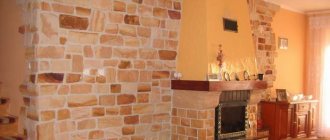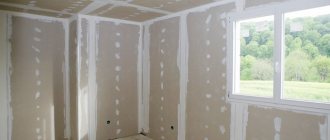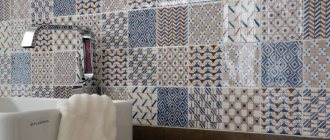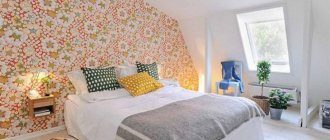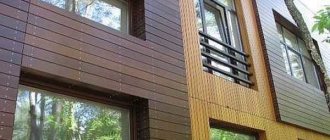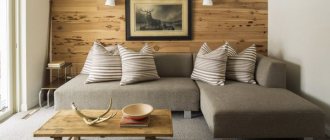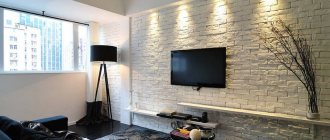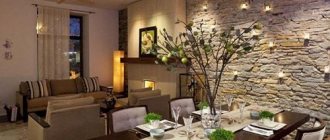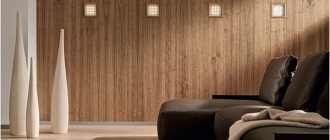In the modern world, people increasingly prefer natural raw materials. Environmentally friendly materials are also important when decorating houses and apartments.
Today, natural coverings made from cork are very popular. That is why the Internet offers a huge selection of photos of cork walls and floors.
Features of cork wall
We have already talked about what wall coverings are made of. The most interesting thing is that the bark is removed manually and is completely painless for the tree. After this, the date of “stripping” is marked on the plant. For what? It turns out that the next similar procedure can be done with the same oak no earlier than in 9 years.
The lifespan of a tree is about 250 years, and each new layer becomes even more beautiful and, accordingly, more expensive.
It is also important that this amazing plant gives us the opportunity to choose the cork in the color that we like best: from light yellow to dark brown.
Payment terms in the regions of the Russian Federation
Choose a convenient payment method.
Non-cash account for an individual
When ordering on the website, the manager will send you an invoice by email, having previously clarified all the information by phone. You can pay your bill at any bank.
Non-cash account for a legal entity with or without VAT
Our manager will contact you by phone and clarify all the details, after which he will send an invoice by email.
Cash on delivery
Pay for the goods upon receipt of the order, making sure that the goods are in proper condition and receiving all the documents.
Payment nuances
Attention! For each individual order, there is only one payment method of your choice. Payment for the order in installments using various methods is not possible. For non-cash payment, you can pay for the order at any bank
For the money transfer service, you will be charged up to 3% of the transferred amount, depending on the bank and region. Transferring money may take up to 3 days.
With non-cash payment, you can pay for your order at any bank. For the money transfer service, you will be charged up to 3% of the transferred amount, depending on the bank and region. Transferring money may take up to 3 days.
When delivering goods to regions of the Russian Federation through a transport company, it is more profitable to make 100% prepayment. For payment upon receipt, transport companies charge an additional fee of up to 4% of the order amount.
Online payment (How to pay via Net Pay)
You can pay for your order online using a card. After receiving the order and processing it by the manager during business hours, you will receive an invoice and a link to pay by card online by email. Payment is credited almost instantly without commission. Shipment within 1-2 business days after payment.
1. To pay by bank card, you will be redirected to a secure payment processing page.
4. If your bank card supports 3D Secure technology, you will automatically be redirected to your bank’s website, where you will be asked to enter a secret activation code, which will be sent to your phone.
5. If the card details are entered correctly and there is enough money in the account, you will see confirmation of payment for the order. After which you will be asked to return to the store page.
Refund procedure
To receive a full or partial refund to your card, you need to contact the store. The money will automatically be returned to your card within 2-3 days. The exact refund period depends on how recently the order was placed and on the bank that issued the card (the maximum refund period cannot exceed 30 days).
Advantages
Cork wall covering is a unique material made by nature itself. It has the following advantages:
- The main advantage is naturalness. Dust does not accumulate on the coating, it does not emit unpleasant odors, is antistatic and can reduce some radiation.
- Lightweight (even used for fishing gear).
- Elasticity and resilience, and the presence of cell membranes is capable of returning to its original shape.
- The surface has anti-mold and anti-rot properties, does not allow liquid and gas to pass through.
- Low heat conductivity.
- High wear resistance and friction level.
- Hypoallergenic.
- Excellent sound and heat insulation.
- Ease and simplicity of installation.
However, this material, which is excellent in all respects for wall upholstery, has a significant drawback - it is expensive. Although today the market offers a large selection of traffic jams, including in the price segment.
Walls
0 votes
+
Vote for!
—
Vote against!
The modern market of wall finishing materials offers more and more new varieties of environmental products. One of the most popular natural materials is cork, which is made from the bark of the cork oak tree, which grows in the Mediterranean countries. Today we’ll talk about the advantages of this material, decorating walls with cork yourself and caring for cork tiles.
- Tools and materials
Features of cork wall coverings
Cork wall covering is made from the bark of the cork tree, which is obtained in the most painless way for the plant. This most valuable natural material is removed from the tree by hand, after which the date is marked. The next time you can get such “clothes” of a tree only after 9 years.
Cork oak lives for about 250 years, and after restoration, each subsequent layer acquires an increasingly beautiful and smooth texture and becomes more valuable. The color range of cork tree bark allows customers to choose many shades: from light yellow to deep brown.
Cork is a unique natural material that has numerous advantages, which are as follows:
- Cork is a natural material, and this is one of its most important positive properties. Dust does not accumulate on cork, it does not have an unpleasant odor, is antistatic and reduces the level of various radiations.
- Cork wall coverings have a low specific gravity. It is even used to make fishing gear, as it is a buoyant material.
- This material is considered to be quite elastic and resilient: after compression, it returns to its original shape due to the presence of flexible cell membranes.
- Cork boards are impermeable to liquids and gases, which is due to the presence of suberin in their structure. Thanks to this, this coating does not rot and mold does not live on its surface.
- The material has low conductivity of heat and vibration due to the presence of gas elements, which are enclosed in microscopic capsules that make up the structure of the cork.
- Cork coverings intended for walls are characterized by great strength: this material is very wear-resistant and has a high level of friction.
- Cork is hypoallergenic and chemically inert. It is safe for health, does not absorb fat, acetone and oil, does not emit harmful substances into the air and does not cause allergies.
- Cork has excellent soundproofing properties, but this requires covering the entire surface of the wall with cork tiles, otherwise the desired effect will not be achieved.
- Cork material, according to most consumers, has excellent thermal insulation properties and helps reduce heat loss. But manufacturers do not claim cork as a complete thermal insulation material. Even the thickest six-millimeter cork tiles will not replace polystyrene foam of similar thickness.
- The plug is quite simple to install and easy to maintain. When installing tiles, no adjustment is required.
The main drawback that many consumers have noted is that cork wall coverings are quite expensive. However, the cost of a cork varies, and anyone always has the opportunity to choose a cork based on the size of their wallet.
Types of cork wall coverings
When choosing cork covering for walls, you need to decide which type of product will be most appropriate in your conditions. This determines, first of all, the decorative effect created by the finishing, the service life of the coating, the complexity of installation and the price of finishing the walls with cork. Before going to the store, be sure to familiarize yourself with the features of the offered assortment on the construction market.
Cork boards
Cork boards are made from granulated cork. They come in one or two layers. When making single-layer slabs, granulated cork is pressed into the desired shape and texture, and then coated with protective wax for additional strength. Typically the substrate is 2 millimeters thick.
When producing two-layer slabs, an adhesive composition based on natural components is applied to the main layer of pressed cork, after which the surface is covered with agglomeronic or natural cork veneer. The base of the slab is very often painted in a certain color, and then it contains colored inclusions. Standard sizes of cork wall tiles are 3 by 300 by 300 and 3 by 600 by 300 millimeters (thickness x length x width).
After applying the decorative layer, the material is coated with protective wax so that it can be used in rooms with low humidity. Nothing will happen to the cork coating itself, because it is not at all afraid of moisture, but the paint and adhesive layer may be damaged. The service life of cork tiles is 10-30 years, depending on the type.
Cork rolls
The next type of cork covering is wall cork in rolls, which is a structure made from a base – a finely crushed and pressed layer of granulated cork and a top decorative layer of cork veneer. The material is produced without the use of synthetic binders. The rolled cork is sold unfinished, and after installing such a cork, the entire surface of the coating is treated with hot wax or varnish to improve the quality characteristics.
Cork in rolls has a smaller thickness than a cork slab - 1.2 - 2 millimeters, due to this it is more elastic and more suitable for combination with other finishing materials, say, wallpaper. Roll coatings are characterized by a large margin of tensile strength, which reaches 2 kilograms per square centimeter.
Rolled cork coverings do not swell and do not come apart during prolonged contact with water, so they are well suited for rooms with high humidity. The service life of coatings in rolls is at least 20 years. Another advantage of cork rolls for walls is the absence of horizontal seams during installation, which allows you to obtain an almost uniform pattern.
Cork wallpaper
Cork wallpaper is the most affordable type of cork wall covering. In their production, they take as a basis a paper web, which is subsequently treated with transparent or colored varnish and covered with thin agglomerated veneer (up to 1 millimeter) of various structures and formats, leaving unfilled areas. Cork wallpaper in modern design harmonizes very well with different finishing materials, be it ordinary wallpaper or just paint.
Cork wallpaper in its strength characteristics is closer to heavy wallpaper - look at the photo of wall decoration with cork. Their structure mainly consists of a large number of pores, so the material has very good sound and heat insulation. This material is lightweight and very elastic, which allows it to withstand significant impact loads. The elasticity of wallpaper and cork makes it easier to work with when pasting.
Cork wallpaper, like all other cork coverings, does not collect dust, does not electrify, which makes its use suitable for residential premises, and is characterized by antibacterial properties. The colors of cork wallpaper include natural tones and various colored inclusions. The service life of cork wallpaper reaches 10 years.
Liquid plug
For exterior wall decoration, it is customary to use the so-called liquid cork, which is not a very common and familiar material for us. The liquid mixture consists of 96% natural cork bark chips and 4% acrylic binder. The material contains millions of tiny pores that are filled with oxygen and nitrogen, contains resins and juice of the suberin plant, which make the liquid plug impermeable to moisture.
A similar composition is applied to the surface by air spraying. Liquid sprayed cork has good adhesion properties to most materials and can be painted in a variety of colors, including bright ones. Using colored cork, you can save on finishing the facade and as a result get beautiful walls. Depending on the purpose, there is liquid cork for facades, roofing and fire-resistant.
Liquid cork can be applied horizontally or vertically, thus leveling certain surface imperfections. The cork layer, which is 3 millimeters thick, perfectly hides almost all technological seams and unevenness of the base, closes shrinkage cracks and microcracks of the facade. It is also customary to use this material as insulation, for noise and waterproofing of a building.
Technical traffic jam
Technical cork is used primarily as a substrate for other types of decorative coatings. Technical cork is made in the form of slabs or rolls of pressed granulated cork without a decorative layer. The rolls have a length of 10 meters, a width of 50 centimeters and a thickness of 1 to 6 millimeters, the dimensions of the plates are 1 by 0.5 meters.
Technical cork, like other materials made from the bark of the cork tree, is a natural material that has a large supply of mechanical strength and excellent sound and heat insulation properties. In addition, this coating is resistant to moisture, insects, rodents and fungus.
One of the distinctive properties of this material is its antiseismicity, that is, its ability to dampen vibrations. Technical cork, depending on the thickness of the coating, can reduce the level of fluctuations by up to 30%. The service life of technical cork material is not limited.
Wall decoration with cork tiles
Modular cork tiles are suitable for cladding walls in any room, including those classified as “wet”. In general, the procedure for decorating walls with cork can be called similar to the process of wallpapering. There are only minor differences, and now we will find out which ones.
Tools and materials
When calculating the number of cork tiles required, it should be taken into account that most slabs are made in sizes 300 by 300 or 300 by 600 millimeters. The thickness of the tiles varies - 2 - 6 millimeters. Before finishing the walls with cork, you need to prepare the following tools: a plumb line, a level, an iron ruler, mounting scissors, a mounting knife, a notched trowel, a velor roller, a container for glue, a roller for processing seams.
Cork tiles are attached to the wall using glue. You can choose contact or acrylic adhesive for these purposes. The use of the latter composition implies one-sided gluing. However, it is still preferable to choose the first option, it will be of better quality.
Contact glue is more difficult to work with, since it requires double-sided gluing: it needs to cover not only the side of the cork board, but also the wall. Make sure that there are no bubbles and that the glue is applied evenly over the entire surface. After applying the glue, you need to wait a little until it sets.
Since cork material is made from natural raw materials, it can change its size depending on the microclimate in the room. Therefore, before you begin, you should unpack the cork tiles and allow them to acclimate and sit indoors for at least 24 hours at room temperature. This procedure will help avoid deformation of the tiles before they are installed on the wall.
Preparing the walls
Any base to which the plug can be attached is allowed (brick, concrete, plaster, wood). It is advisable to carry out work at an air humidity of about 35 - 65%; in extreme cases, you can always use a humidifier. The air temperature should not drop below 18 degrees in the room. Remember that the humidity of the walls in the room should not exceed 3%.
Before attaching cork tiles to the walls, you must carefully prepare the surface of the walls. If there is a need, then level them and cover them with a primer. To prime and level the wall, you should use only those compounds that are compatible with this type of finish. It is not recommended to use various putties, screeds and putties based on gypsum.
Then determine the center of the wall; for this it is customary to use a plumb line and level. Then draw two lines: vertical and horizontal; to draw them straight, you need to use a plumb line and a ruler. These lines must pass through the center point. As a result, it turns out that the wall is divided into two even parts horizontally and vertically.
Fastening tiles
Then take the first tile and place it at the intersection of the axes, outline it along the contour and apply a thin layer of glue to approximately 1 square meter. The tile is laid after applying the adhesive in such a way that its lower edge is located on the line of gluing to the wall. First you need to glue the bottom edge of the tile, and then press the entire rest of the surface so that no bubbles form under the tile and the tile sticks tightly.
When gluing tiles to walls, it is necessary to take into account the natural origin of cork. The structure of this material is such that it can break quite easily, so you should not lift the slabs by the corners, because they can break off and remain between your fingers. The material must be moved carefully, as shown in the video about decorating walls with cork.
Next, you need to completely glue the entire row, using the “running” technique, which is used for laying bricks. This method eliminates the appearance of uneven vertical lines, and they appear with the slightest change in the size of the tiles. Thus, it is customary to lay the second row with a shift relative to the first.
The edge of the first tile will be placed exactly in the center of the bottom tile, all this will be repeated for each next row. Don’t be afraid if the slab is not laid very level right away - you can move it along the surface of the walls until the adhesive composition hardens. Roll the joints using a special roller to avoid peeling off the corners.
Edge decoration
When finishing wall surfaces with cork tiles, the design of the edges is considered important. This is done by laying one slab on top of another, with which the surface is finished. To do this, you need to measure the distance from the walls and mark the place for gluing the edges. Then cut the tile along the marked lines with a cutting knife. If the edge design areas are narrow, then in this case it is worth applying glue to the tiles.
In the places where switches and sockets are located, to simplify your work, you need to use templates that need to be cut out and applied to the switch or socket. It is recommended to use thick paper for templates. After making the template, it is applied to the cork board and cut out, then glued in the designated area.
Cork tile care
Sometimes, despite your efforts, cracks and gaps remain between the sheets of cork. But this is also explained by the product’s ability to expand and contract. Don't worry, as this is quite easy to fix. Carefully insert and glue a thin strip of cork into the gap. Lift up the peeled edges and corners and coat with glue using a thin brush. Leave excess glue until completely dry, then remove with a knife.
To protect the cork coating from premature wear and increase its performance properties, it is customary to use special products. Since ancient times, coatings made from natural materials have been coated with oil and wax. A modern analogue of such substances is a special composition called oil-wax. Cork tiles treated with this composition do not absorb moisture and can be used in kitchens and bathrooms.
Another way to protect the surface of wall cork is to coat it with a special varnish: two-component polyurethane, water-based acrylic or ceramic. Remember that the use of parquet varnish is prohibited.
In addition, cork tiles, like other products made from natural materials, are susceptible to sunlight. Under the influence of ultraviolet rays, such slabs can change their color. To prevent such burnout of the cork, make sure there are curtains when finishing vertical surfaces.
Purchasing material
Today, the question of where to buy cork walls disappears by itself. The fact is that this material is now sold not only in stores on the ground, but also in online markets. All you have to do is go to the website, select the product that suits you in all respects and place an order.
Types of cork material:
- slabs;
- rolls;
- wallpaper;
- boards;
- liquid;
- technical.
Payment terms in St. Petersburg and regions of the Russian Federation
Choose a convenient payment method.
Non-cash account for an individual
When ordering on the website, the manager will send you an invoice by email, having previously clarified all the information by phone. You can pay your bill at any bank.
Non-cash account for a legal entity with or without VAT
Our manager will contact you by phone and clarify all the details, after which he will send an invoice by email.
Cash on delivery
Pay for the goods upon receipt of the order, making sure that the goods are in proper condition and receiving all the documents.
Payment nuances
Attention! For each individual order, there is only one payment method of your choice. Payment for the order in installments using various methods is not possible. For non-cash payment, you can pay for the order at any bank
For the money transfer service, you will be charged up to 3% of the transferred amount, depending on the bank and region. Transferring money may take up to 3 days.
With non-cash payment, you can pay for your order at any bank. For the money transfer service, you will be charged up to 3% of the transferred amount, depending on the bank and region. Transferring money may take up to 3 days.
When delivering goods to regions of the Russian Federation through a transport company, it is more profitable to make 100% prepayment. For payment upon receipt, transport companies charge an additional fee of up to 4% of the order amount.
Online payment (How to pay via Net Pay)
You can pay for your order online using a card. After receiving the order and processing it by the manager during business hours, you will receive an invoice and a link to pay by card online by email. Payment is credited almost instantly without commission. Shipment within 1-2 business days after payment.
1. To pay by bank card, you will be redirected to a secure payment processing page.
4. If your bank card supports 3D Secure technology, you will automatically be redirected to your bank’s website, where you will be asked to enter a secret activation code, which will be sent to your phone.
5. If the card details are entered correctly and there is enough money in the account, you will see confirmation of payment for the order. After which you will be asked to return to the store page.
Refund procedure
To receive a full or partial refund to your card, you need to contact the store. The money will automatically be returned to your card within 2-3 days. The exact refund period depends on how recently the order was placed and on the bank that issued the card (the maximum refund period cannot exceed 30 days).
How is cork used?
A cork board on the wall is a godsend for those who are used to recording some important matters on the surface. You can also attach notes, pictures, advertisements, photographs, etc. to it.
Such stands are most often used in educational institutions and offices. However, practice shows that more and more often such boards can be seen at home, for example, in the form of a key holder.
Cork rolls for walls contain crushed and compressed crumbs at their base, and although they are visually similar to cork wallpaper, there is still a difference between them. The main difference is that wallpaper has a non-woven or paper base. This makes pasting easier.
Rolls are made only from cork. Their thickness is within 2 mm. They have high heat and sound insulation. Special glue is required for installation.
Vinyl
A class of wallpaper based on paper or non-woven fabric coated with polyvinyl chloride (PVC) is usually called washable.
They can be smooth, with a flat pattern or with expressive relief.
In terms of composition, PVC is a colorless plastic that has properties beneficial for wall coverings. It repels fat, is resistant to moisture, salts, alkalis, acids, and does not burn well.
Structural wallpaper with screen printing and subsequent vinyl foaming, intended for painting. Very dense, with many interesting textures, which allows you to create an original interior and at the same time hide uneven walls.
Hot stamping vinyl wallpaper, within which there are also varieties:
- heavy vinyl is applied as a continuous film and is characterized by increased density, which allows you to hide flaws in the surface being pasted. The other side of the coin is airtightness, which precludes the use of such coatings in the bedroom;
- Compact vinyl has a textured surface in the form of natural materials, brush strokes and even frescoes. Due to their strength, they can withstand any mechanical impact and can be cleaned with a brush.
- Silk-screen printing creates the effect of a noble silk shine due to pressing at very high temperatures. Very demanding on the base to be pasted: it emphasizes all the irregularities and flaws of the walls.
- Inhibited vinyl is produced by chemical embossing, popularly called washable. Indeed, it has high strength indicators, does not fade, and is not afraid of cleaning with detergents.
Hot-stamped vinyl wallpaper is durable, resistant to moisture, sunlight, heating devices and easy to clean. They would rather annoy their owners than lose their appearance.
Installation of such wallpaper is not a problem. If the technology is followed, they adhere well to any surface - both wood and concrete, while masking minor finishing imperfections.
In view of this, they can be used as part of heat-storing systems. There are few disadvantages to such roll coverings.
However, when deciding which wallpaper is better to choose, either vinyl, or paper, or non-woven, you need to take into account the following factors.
Vinyl wallpaper stretches when wet and contracts when dry. If active smoothing occurs during pasting, the joints of the dried canvases may shift.
The airtightness of the material requires maintaining dry indoor air to prevent mold. To solve this problem, some manufacturers create vinyl flooring with perforations that are easy to see through light.
The question of the environmental friendliness of vinyl is also controversial. When heated, PVC releases toxic gases, but manufacturers claim that during the hot stamping process, toxic substances are evaporated.
How to choose material
Cork coverings for wall decoration must be chosen carefully. It is necessary to take into account such factors as: decorative effect, service life, complexity of installation.
Before purchasing material, you need to familiarize yourself with the features of the range offered on the construction market.
Insulators ShF-20G- Production of plastic for finishing
How and how to caulk a timber house with your own hands: materials and step-by-step instructions
Rules of care
Cork wall coverings are less likely to be damaged during use than floor coverings, but this does not mean that they do not require maintenance. Thus, to protect the material from premature deformation and wear, a composition of oil and wax is used. The same product can significantly improve the characteristics of the cork surface, in particular, making it more moisture resistant. Thanks to this, finishing with cork can be done even in the bathroom and kitchen, where, it’s no secret, the humidity is usually higher than in other rooms. To protect the surface, you can also use water-based acrylic varnish as an alternative to oil-based compounds. The most important thing to remember is that you cannot cover the cork with parquet varnish.
Such a coating does not require special care during its operation. It will be enough to periodically wipe the surface with a damp cloth. Any detergent can be used, except those that contain solvents and abrasives.
Don't forget that cork is one of the natural materials that is susceptible to sunlight. Due to an excess of sunlight, the coating may fade and lose its natural color. Sometimes the cork can even dry out, causing the material to change dimensions. If this does happen, it is recommended to maintain a humid environment in the room. And you should definitely hang curtains or thick curtains on the windows.
What affects the cost of cork material
I would like to immediately note that any natural material is more expensive than artificial. All the advantages of cork are described above, which is also one of the factors of high cost.
In addition, the price of cork wall coverings depends on the manufacturer. But that's not all. The fact is that cork is produced in different thicknesses, therefore, the thicker the material, the higher the performance. And this is undoubtedly expressed in an increase in the price of the product. And yet, if you are for naturalness, then by all means buy a cork.
Expert advice
Sometimes there are gaps between the parts of the cork. To avoid them, you need to attach the edges to the wall so that the sheet becomes curved by approximately 4 mm, then run a roller over the surface, pressing the sheet or tile into the desired space. In this case, the walls will look perfect.
Although environmentally friendly cork is not a cheap option, it is so practical that buyers appreciate it. If you follow all the rules for decorating walls with cork and know its properties, it is quite possible to turn the interior into a comfortable zone with your own hands, which will delight the owners for a long time.
